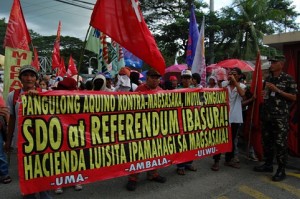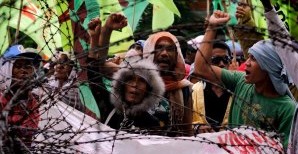By HOMER TEODORO
THERE’S a brewing tension between labor unions and 10 barangay chairmen of Hacienda Luisita because of their conflicting lists of farmer-beneficiaries considered to own and possess the 4,915.75-hectare sugar land estate of the Cojuangco family in Tarlac.
The Alyansa ng mga Manggagawang Bukid sa Asyenda Luisita (AMBALA), the United Luisita Workers Union (ULWU), and the 10 barangay chairmen have their own list of beneficiaries to be given agricultural lands in Hacienda Luisita.
AMBALA and ULWU began taking over the 300 hectares of the Cojuangco sugar estate that had been sold to Rizal Commercial Banking Corporation (RCBC) as well as the large tract of land which the Hacienda Luisita supervisors occupied following the Supreme Court ruling of Nov. 24, 2011.
In that decision, the high tribunal ordered the Hacienda Luisita, Incorporated (HLI) to distribute the land to the farmers in line with the laws governing the Comprehensive Agrarian Reform Program (CARP).
The HLI filed a motion for reconsideration claiming P10 billion as just compensation, which is still pending in court.
The farmers, for their part, demanded their share in the amount paid by the Government for the sale of part of the contested land now being used by the Subic-Clark-Tarlac Expressway (SCTEX) and the Luisita Industrial Park.
To avoid any untoward incident, the 10 barangay chairmen invited the military inside the hacienda, a move that militant farmers did not welcome as they do not want the military to have a part in the internal problem of Hacienda Luisita.
 Bishop Florentino Cinense of the Tarlac Diocese expressed fear that Hacienda Luisita which everybody claims as theirs may not be enough land to bury the dead bodies if a worst-case scenario happens.
Bishop Florentino Cinense of the Tarlac Diocese expressed fear that Hacienda Luisita which everybody claims as theirs may not be enough land to bury the dead bodies if a worst-case scenario happens.
It could be recalled that hundreds were wounded and seven farmers killed in the November 2004 rally in front of the Central Azucarera de Tarlac (CAT) — Hacienda Luisita’s sugar mill.
Indeed, gone were the days when life was simple and peaceful inside Hacienda Luisita.
Old residents of the sugar plantation recalled that everybody was rejoicing every time the month of September came because this signaled the beginning of the “Kabyaw” (milling season of sugarcane) that lasted for about six or seven months.
Hundreds of 6×6 trucks loaded with tons and tons of freshly cut sugarcane lined up at the CAT yard, waiting to unload their precious cargo. A thanksgiving mass for the pre-milling and post-milling season was offered at the Lourdes Church of Barangay (Village) Central.
Before Christmas Day, the workers received their Christmas bonuses while their children happily lined up in front of the CAT gate, waiting for their names to be called to receive gifts of toys and some cash.
After the Kabyaw, a sports competition among workers and staff of the departments of the sugar factory was staged. This was the regular cycle of life inside Hacienda Luisita then.
The late Benigno Simeon “Ninoy” Aquino, Jr., husband of former president Corazon Cojuangco-Aquino, was the first CAT administrator and farm manager of Hacienda Luisita.
The income of CAT was doubled when it began milling refined sugar in 1964. Forming a Union was encouraged hence the birth of the ULWU and the Central Azucarera de Tarlac Labor Union (CATLU).
In 1970, the farm workers and laborers inside Hacienda Luisita staged their first strike. They demanded that the land be distributed to them. The leader of the strike, a certain Samut, was kidnapped and was not seen anymore.
The new leaders opted for a Collective Bargaining Agreement between CATLU and Management. Among the benefits given the farmers were free medical consultation and hospitalization; monthly medicine allowance for the permanent employees; signing bonus; overtime and night premium; Christmas bonus; midyear bonus; and 13th month pay.
In 1980, the Marcos regime filed a case against the Tarlac Development Corporation (TADECO), a corporation engaged mainly in agriculture owned by Jose Cojuangco, at the Manila Regional Trial Court in order to put Hacienda Luisita under the control of the Ministry of the Agrarian Reform and to distribute it to the peasant farmers.
The political rivalry of Marcos and Ninoy was already in its peak by this time. In 1985, the Manila RTC released the decision ordering the TADECO to place Hacienda Luisita under the Ministry of the Agrarian Reform after the Government paid the owner P3, 988 million. The decision was not implemented because of the EDSA Revolution.
During the Cory Aquino administration, the Solicitor General, the Department of Agrarian Reform (DAR) and Bangko Central appealed in 1988 the RTC decision of 1985 before the Court of Appeals. The CA junked the RTC decision.
On June 10, 1988, the Comprehensive Agrarian Reform Program Act became a law. The government proudly announced that the CARP would become the cornerstone of the Aquino Administration and Hacienda Luisita would be the showcase of this program.
But Agrarian Reform Secretary Philip Juico, the president’s sister-in-law Margarita “Ting-Ting” Cojuangco, and the town mayors of Tarlac City, La Paz and Concepcion formulated the Stock Distribution Option (SDO) scheme through a “referendum” to make it appear that the Hacienda Luisita workers liked the SDO better than to own a piece of land.
Stock certificates were distributed to the workers. Yet, they grew restless against the Cojuangco management because the benefits promised them were not delivered like their 33% shares in the conversion of the land into industrial, the dividends of stock shares, and their work pay became small, among other things.
The farmers believe that peace will only be achieved inside Hacienda Luisita if the land will be distributed to them, saying “NO Land, NO Peace.”

